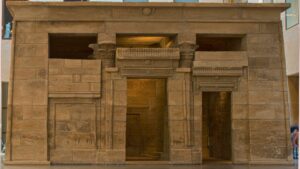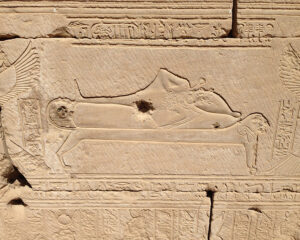
Online lezingen in mei
Dinsdag 4 mei
Dr. Mary Ann Marazzi
Ished tree scenes in ancient Egypt
Evidence for ished tree scenes date from the reigns of Thutmosis I through that of the Roman ruler Hadrian. They appeared in both texts and images on temple walls and other monuments including obelisks, stelae, and statuary, but until recently they were not understood that well and were not collected and analysed as a unit. This presentation gives an overview of what an ished tree scene is and the function it had in ancient Egypt including a possible sequence of events for the ritual of the ished tree as well as who could see the images and read the texts.
4-6 mei
The Egyptological Conference in Copenhagen 2021
The theme of this year’s conference is trade and administration in Ancient Egypt, however, the presentations will cover a variety of topics within the field of Egyptology and archaeology.
Zaterdag 8 mei
Rosalind Janssen, Janet Johnstone & Elizabeth Clancy
Early Fashion and Textiles by the Nile, Euphrates and Tigris: Conversations
This panel brings together scholars and practitioners who will introduce their studies of and encounters with ancient textiles, clothes, and fashion. Exploring practical textile and dress making techniques of the cultures along the Nile, Euphrates and Tigris rivers during the 3rd millennium BCE, they ask: How was fashion used to express cultural, societal, and personal identities? Find out how ancient fashion and clothes making techniques can influence the way we make, design, and wear textiles today.
Zaterdag 8 mei
Kelsey Museum
Animals in the Ancient World
Animals abound in the art and artifacts of the ancient Near East, Greece, Egypt, and Rome. On this guided tour, learn more about different aspects of animals in antiquity. We’ll take a look at animal-themed artifacts in the Kelsey and ask: Was that animal food? A laborer? A pet? A sacrificial victim? We’ll also discuss what kinds of animals were symbols of power and strength, and the meanings different animals had in the ancient world.
 Zondag 9 mei
Zondag 9 mei
Dr. Daniel Soliman
Topstukkenlezing over de tempel van Taffeh
De tempel van Taffeh, die in de grote entreehal van het Rijksmuseum van Oudheden staat, werd in de 1ste eeuw na Chr. gebouwd in Taphis, een stad in het diepe zuiden van Egypte. Twee millennia later schonk de Egyptische overheid de tempel aan het Nederlandse volk. Deze lezing gaat over de lange geschiedenis van de tempel en de verschillende manieren waarop het gebouw door de eeuwen heen een bijzondere plek is geweest. Daniel Solimans verhaal neemt u mee op een reis door de tijd: van de Romeinse periode, via de laatantieke periode, de middeleeuwen, en de tweede helft van de vorige eeuw, naar de dag van vandaag.
Zondag 9 mei
Dr. Mariam Ayad
The God’s Wives of Amun
Kosten: £4
Since its inception at the beginning of the 18th dynasty, the office of the God’s Wife of Amun was closely associated with the priesthood. By the time the office reached its zenith in the 23-26th dynasty, that association became immortalized in the iconography of the God’s Wife’s small Osirian chapels at Karnak. This illustrated lecture focuses on the priestly duties of the God’s Wife and what might those scenes tell us about her status and role more broadly.
 Dinsdag 11 mei
Dinsdag 11 mei
Manon Schutz
Sleeping on the goddess’ back. The meaning of beds in ancient Egypt
Kosten: gratis voor donateurs en studenten, €5 voor niet-donateurs
Voertaal: Engels
In deze lezing vertelt Manon Schutz ons in detail over de functie van bedden in het oude Egypte. Na een algemene inleiding en een definitie van het concept ‘bed’, worden het gebruik en de religieuze betekenis van dit meubelstuk besproken voor verschillende stadia van zijn lange geschiedenis. De nadruk zal vooral liggen op de funeraire sfeer, aangezien de meeste overgeleverde bedden afkomstig zijn uit graven. Daarnaast zal ook het gebruik van bedden in de dagelijkse praktijk worden besproken.
Woensdag 12 mei
Two lectures by MA students at Swansea University
Wig Snatched: Unveiling the process behind wig-making and the wig industry in ancient Egypt / From rats to robber flies: active pest control in ancient Egypt
Zaterdag 15 mei
Dr. Chris Naunton
The Amarna Blessed Dead
Kosten: £5
What happened after Akhenaten’s death? Where was he buried? Who succeeded him? We know that Tutankhamun’s reign saw the end of Akhenaten’s revolution and the restoration of the old ways, and the boy-king himself was the last of the family line. But it seems clear that there was at least one other pharaoh in between Akhenaten and Tutankhamun. Who were they? Could it have been Nefertiti? And who was Smenkhkare? Tantalising clues have been in tombs at Amarna and in the Valley of Kings. But how to make sense of them?
Woensdag 19 mei
Daniela Rosenow & Matthieu Götz
Dahschur – Recent Research in the Old Kingdom Settlement
Dahshur is one of the most important royal pyramid cemeteries of Ancient Egypt. The first part of this lecture will highlight one of the most recent discoveries, a new settlement most likely inhabited by the people who planned the pyramids. The second part will explore the application of latest technologies, benefiting archaeology, conservation and site managenment.
Woensdag 19 mei
Dr. Kucera (Qasr Dakhleh Project)
Archaeological investigations at al-Qasr and the Roman fort of Dakhleh Oasis
For several years after the discovery of Greek documents at Kellis (Ismant al-Kharab), which revealed the existence of a Roman military camp (castrum) in the 4th century CE in Dakhleh Oasis, the location of a fort remained elusive for researchers. Between 2006 and 2007, a possible location for the fort was realised when the remains of substantially large walls and unusual structural features were observed at the Islamic settlement al-Qasr. This talk presents the results of surveys and excavations that lead to the identification of the fort, further discoveries related to the occupation of the site, and a review of the findings in light of the Roman military presence in the Western Desert.
Woensdag 19 mei
John C. Darnell (Yale University)
Setting a seal upon the desert: Protodynastic and Early Dynastyc augmentation and interpretation of Predynastic rock art in the Upper Egyptian desert
Registreren via gaelle.chantrain@yale.edu
Donderdag 20 mei
Cédric Gobeil (Museo Egizio, Turin)
In the footsteps of Ernesto Schiaparelli. The Museo Egizio’s current research at Deir El-Medina
Within the framework of the French Archaeological mission at Deir El-Medina carried by the IFAO, the Museo Egizio of Turin is conducting research on a few Ramesside tombs located in the Western necropolis. These tombs have been chosen based on the many artifacts that belonged to the owners of these tombs and are now kept in the museum. In addition to giving the opportunity to perform a study on these fragile structures using new technologies, this fieldwork is a unique chance to recontextualize many objects of the museum’s collection by shedding a new and fresh light on them. This talk will be the opportunity to get a first glimpse at this work in progress.
Donderdag 20 mei
Prof. Dr. Jochem Kahl
Wo Myrrhe nicht mehr regnen und Weihrauch nicht mehr tropfen kann – Die verschollenen Tempel von Assiut
Donderdag 20 mei
The Egypt Centre Curator’s Chats
Ancient Egyptian Textiles
Using items within the museum’s own collection as well as examples from elsewhere, we will discuss the importance of textiles in Ancient Egypt. We shall briefly explore textiles used for the preparation of death including a rare painted shroud dating back over 3000 years, and consider theories as to how the ancients were able to pleat their garments. We will also look at the “Coptic” textiles in the museum including some which are said to have been designed with the intent of tricking the evil eye.
Vrijdag 21 mei
7th Annual Birmingham Egyptology Symposium
Biography in ancient Egypt
Zaterdag 29 mei
Dr. Mennat-Allah El Dorry
Egyptian History and its Many Cuisines: An Exploration of Egyptian Food History
What is Egyptian cuisine? It is an amalgamation of thousands of years of culinary innovations, technological developments, and new crops and flavors. Egyptian cuisine(s) change(s) from one region to the next, and from one time period to another. This talk will explore the cuisines of each phase of Egyptian history, identifying some of the highlights or developments of each time period, starting with ancient Egypt and through to the 20th century. It will also investigate the transformations, and how these may or may not have had an impact on the face of today’s Egyptian food. The paper will also survey the different sources that scholars have available in order to study the history of Egyptian cuisine.
Zondag 30 mei
Dr. Joanne Backhouse
Women of Deir el-Medina
Kosten: £5
Deir el-Medina housed the craftsmen who created the royal tombs during the New Kingdom. We often consider the lives of the workmen but less so the female residents. Examining predominantly figured and hieratic ostraca, female figurines, stela, and tomb scenes this talk attempts to shed light onto the daily lives of the female inhabitants. Their religious practices and afterlife expectations will also be considered.
